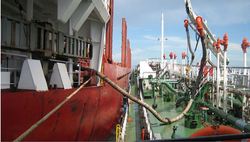Fuel price spreads show signs of IMO 2020 impact

On the one hand, the gasoil premium to Brent crude has risen, reflecting increased demand. On the other, the heavy fuel oil discount to low-sulphur fuels has widened as the shipping world prepares for IMO 2020.
Heavy fuel oil prices have fallen to the lowest level in three years.
WITH less than three months to go before the deadline for the International Maritime Organization’s low sulphur rules, the shipping community has finally embarked in earnest on the mandatory transition, which is being reflected in the price spread between compliant and non-compliant fuels.
Heavy fuel oil prices have fallen to their lowest in almost three years in the major hub of Rotterdam, as the world’s ocean-going ships start filling up with fuel complying with the regulatory sulphur cap of 0.5%, which takes effect on January 1.
Prices of high-sulphur fuel oil with a 3.5% sulphur content fell to below $200 per tonne on October 18 as the deadline nears, assessments from oil market pricing agency Platts showed.
These recent trades saw HSFO prices collapse to levels not seen since early 2016, Facts Global Energy’s head of refining Steve Sawyer said.
Mr Sawyer also viewed this sharp drop, which saw HSFO trading at a $30 per barrel discount to Brent in the Amsterdam-Rotterdam-Antwerp region, as taking place “slightly quicker than anticipated”. That is the widest margin since the first half of 2008.
What would have pushed shipowners to make the low-sulphur switch earlier rather than later this year, is a tightness in HSFO supply, particularly in Asia — the host region for the fastest-growing tonnage providers.
Platts’ head of analytics Chris Midgley said: “Traders have sold off HSFO stocks to free up storage for very low-sulphur fuel (containing no more than 0.5% sulphur) in anticipation of a large drop in HSFO demand at the end of the year.”
At the world’s busiest bunkering port of Singapore, however, shipowners were recently caught by HSFO supply tightening before they embarked on switching to compliant fuels.
That drove up cash premiums for HSFO in Singapore as the port nation holds less HSFO in stock compared to bunker hubs in other regions, Mr Midgley explained.
Platts assessments also showed HSFO prices peaking at $518.90 per tonne on September 17.
At Rotterdam, which came in second only to Singapore in bunker sales last year, HSFO prices also rebounded to above $300 per tonne on September 12.
But HSFO prices did not hold up for long, with Platts assessments on Singapore trades reflecting a drastic drop to a low of $280.17 per tonne on October 7, the first time the oil-based product was seen trading at below $300 this year.
The price spread between Singapore trades on 0.5% and 3.5% sulphur fuel oil, or the difference between very low-sulphur fuel oil and HSFO, has widened significantly since early September, Platts data showed.